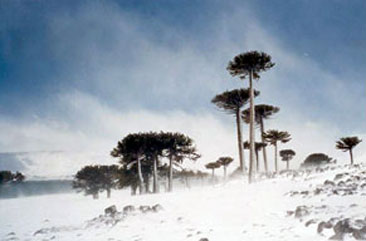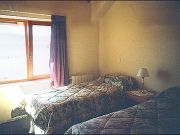Araucarias: the symbol of Neuquén See map
The tree that for centuries nourished and protected the ancestors
Is the symbol of Neuquén. It could almost be said its trademark, although only a portion of the province is covered by them. Its remarkable distinction from other tree and plant species cover the Patagonia making it known where it is seen.
They survive in a very small handful of sites in the world, but alone, against wind and cold, the araucarias have adapted to this land and have won, of course, a place. There, where only the toughest shrubs can withstand harsh winters, these species continue to grow as reaching for the sky with their sharp branches.
But above all things, the Araucaria is the label that illustrates all the postals of Caviahue and that welcomes those who come to this town.
 Landscape of araucarias.
Landscape of araucarias.The ancient indigenous, the Pehuenches, knew this tree with another name: pehuén. From there, that the area where most of these forests are is called Villa Pehuenia. The Pehuenches had up to a deity by the name of this species. Is that for centuries it was almost their only food. With its seeds, the piñones, they made bread, wine and even stews.
Later, scientists have discovered that a man would need, at most, 18 trees per year to survive, as they have in the proper proportions the food necessary for proper metabolism.
Araucaria forests grow to more than 1,000 meters above sea level, between Lake Caviahue and the north of Lake Lolog, on both sides of the mountain range. Their growth is very slow, but they can reach heights of 40 meters. It would not be unusual for a pehuen that fed those old araucanos that is still standing, because an araucaria can achieve to live from 500 to 1,000 years. Even some of the earliest specimens of South America have 3,000 years.
And, unlike other vegetables, anyone could easily recognize in this species the male of female. The male pehuén has 5 or 6 branches protruding from the cup, as directed, long, upward, while the female, known as piñonera, gives a pineapple every two years.
The pehuén's wood is of excellent quality, but its use is limited given the rarity of the species. In fact, in 1941 the province of Neuquén created the Caviahue-Copahue Park to protect the pehuenes or araucarias's forests, attractive characteristic of the region.
Although they are the hallmark of Caviahue from its neighbor desert Copahue, its growth is not only gives there. In Patagonia, there araucaria forests in the northwest of Neuquén, between border Arco, Pino Hachado and Mallin de Icalma, but also around the lake Aluminé and volcano Lanín.
To learn more of this ancient species, Patagonia.com.ar proposes you a weekend's circuit by the ancient araucaria forests scattered throughout the province.
Alojamiento en Caviahue
 Apart Hotel Lago Caviahue
Ubicado en la costa del Lago Caviahue nuestro stablecimiento lo espera todo el año con todos los servicios y la mejorver másTel: +54 2948 49-5074Caviahue
Apart Hotel Lago Caviahue
Ubicado en la costa del Lago Caviahue nuestro stablecimiento lo espera todo el año con todos los servicios y la mejorver másTel: +54 2948 49-5074CaviahueViajes por la Patagonia
Related Articles
© Patagonia.com.ar 2025 | Todos los derechos reservados.
